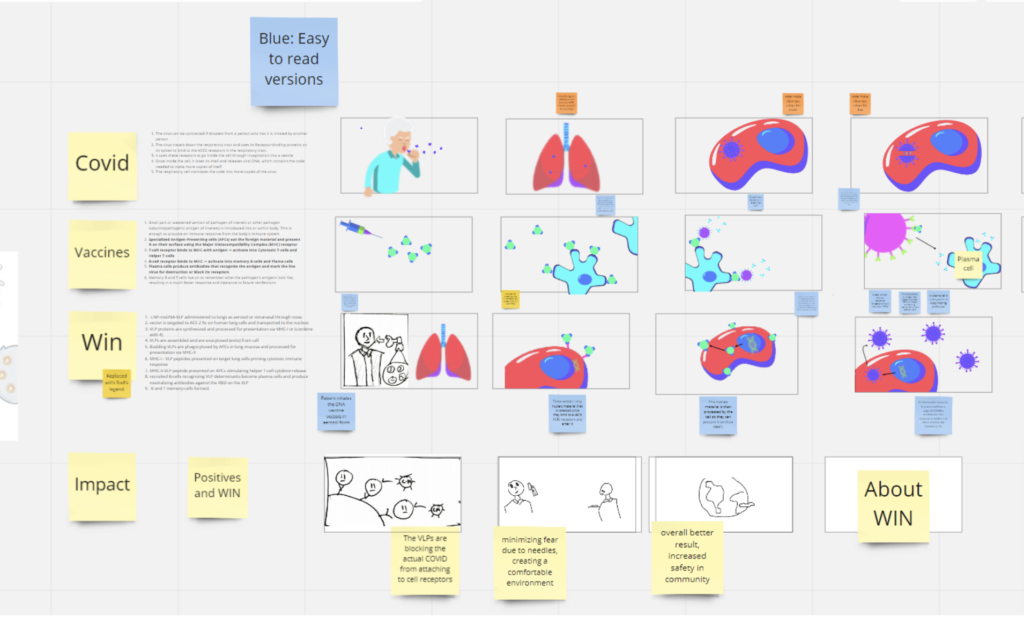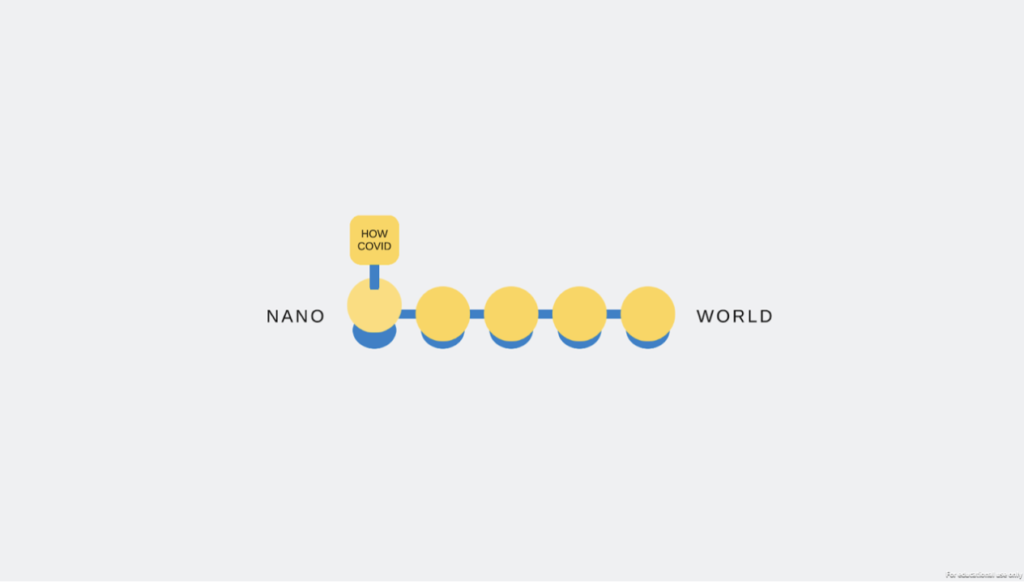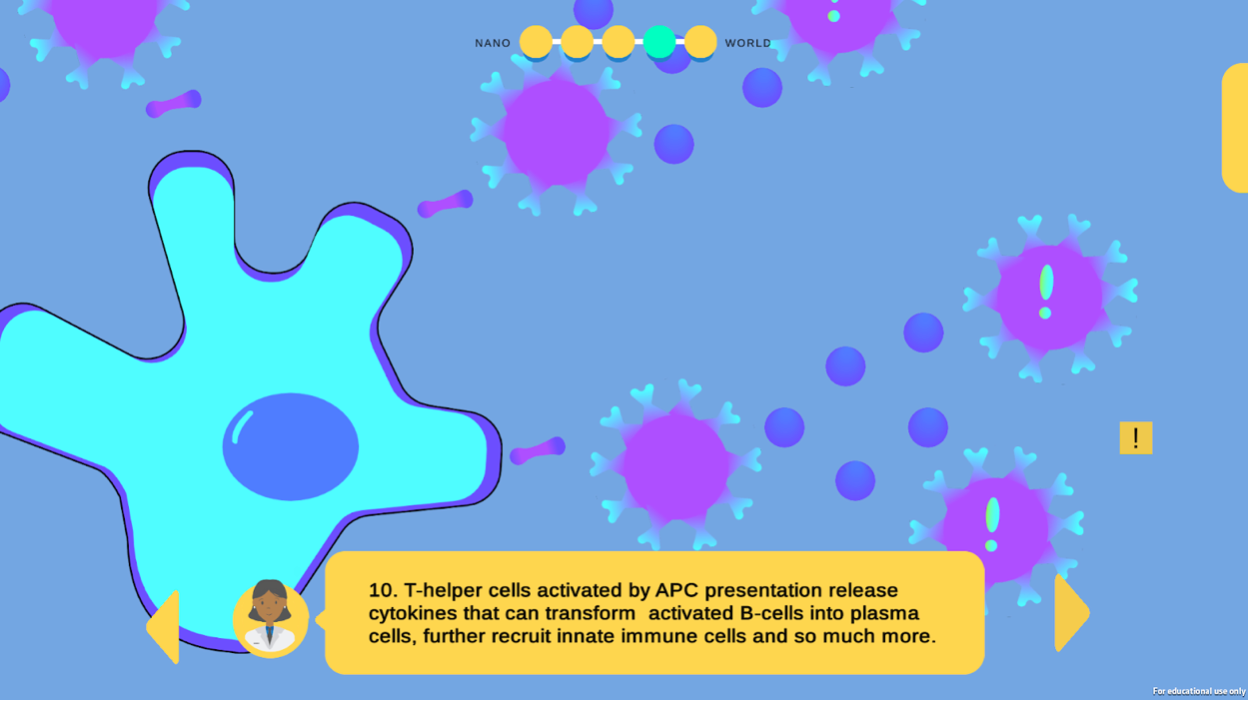Knowledge translation is applicable in several areas and fields of research. It serves as an excellent process to present detailed and complex research into something that can be understood and digested by a general audience. As two Undergraduate Research Assistants in the HCI Games Group, we were part of a knowledge translation project in partnership with the Waterloo Institute for Nanotechnology (WIN). Our main task was to design an interactive game or gamified application that explains Dr. Roderick Slavcev’s research on a novel COVID-19 vaccine. As Health Studies students, our roles were to help our team understand the provided content to translate this information into another media form—in this case, a game. We worked closely with the designers and game developers throughout the whole process of curating the final content.
This knowledge translation project served to be an eye-opening research experience for both of us because we learned how to transform and break down the informative text into something fun and exciting. We have outlined the steps that we took throughout the entire process of this project:
Pre-Planning Phase for Knowledge Translation
This phase of the project consisted mostly of brainstorming to generate ideas for what we would like in the end product. We began with many team meetings to assign operational roles and form ideas of what we think is the most suitable medium for the project, such as ideas around visual novels and interactive games. The team then held meetings with the project stakeholders to present our ideas and to ensure that we are on the right track to satisfy their expectations for what they would like created. We initially clarified their project preferences, asking them questions such as how they want us to present the information, their preferred art style, and many more. We found great importance in understanding the general audience that this would be presented to, as this helped us formulate specific game parameters such as language, tone, length, and design. We use what we have gathered from these meetings to set reasonable team goals and timelines that we would like to meet. We found platforms such as Miro (which we have used extensively during the pandemic as a collaboration tool in the HCI Games Group) to be useful in this pre-planning and brainstorming phase.
Knowledge Extraction
The knowledge extraction phase took up most of our time in this project because we were assigned roles to translate the research content for better presentation in the game. We had to make sure that we were outlining the correct information before creating the product. To accomplish this, we took the content, such as diagrams and research papers from our project stakeholders (WIN). We proceeded to break them down into information that can be presented to and understood by our audience. We used many other resources to guide us in this process, such as referencing other reliable research papers and textbooks and exploring other media forms, such as YouTube videos (shoutout to CrashCourse and the Amoeba Sisters).
Creating a game about a complex topic, such as how vaccines work, was a big challenge. We had to consider several factors to ensure that the content we were producing would make sense and appeal to the general audience and encapsulate the ideas from the original research papers. We had to understand the amount of background knowledge that our audience would have about this topic. The topic is the development of a novel COVID-19 vaccine, which means that there are complex biological terms that not everyone would understand, possibly hindering their interest in playing the game. As we extracted the information for the game, we tried thinking of different ways to present the content so that the general public would understand. We all agreed that the best way to do this is to break down the significant processes into smaller pieces to make them more digestible.

This way, we were able to make sure that the content will make sense to the audience while still accurately capturing the extensive research information. We also received guidance from Dr. Slavcev throughout the entire process of extracting information from his work to incorporate in the game, ensuring that everything we were writing made sense and met the project’s expectations. Communication is crucial in a project such as this. Poor communication can lead to challenges such as one we will be talking about in a later section.
Building the Knowledge Translation Game
Our team built the game using Unity, and although we both principally focused on content development, we were still able to see building the game through working with the design and game development students. It was an iterative process wherein we created countless prototypes and different storyboard versions. We also created a spreadsheet that outlined the required assets and visual references to guide the design team.
Like the storyboards, there were also many iterations made for the build of the game. In the early stages, we started producing builds that would test the game’s functionality and layout – showing what is clickable and showing how to progress through the game.

As we progressed, assets slowly populated the game and their accompanying text descriptions we laid out from the storyboard. The process of finalizing everything required extraordinary attention to detail and precision. We squashed bugs through continuous testing and much double-checking. We made sure the information in the game matched what we had laid out in storyboards.

An essential factor in a knowledge translation project that we have realized is the need to make sure that what we are presenting is accurate and clearly outlines the original research message. Throughout building the game, we worked closely with the whole team to clarify what content the game presents to the players.
Challenges and Limitations
Of course, no project would come without its challenges. One of the biggest hurdles our team faced was time. We originally built a concrete project plan and timeline, but as we progressed in creating the product, we failed to account for several factors that caused us not to meet our expected timeline and end date. We did not consider all the iterations we needed along the way for both the content creation and the game’s build. Then we received a mass of information that we needed to break down into something both accurate and audience-friendly, which took a lot of trial and error. Doing this caused a delay in creating the game because we needed to complete the information to understand how to design it. Besides this, building the actual game in Unity also faced its challenges, such as ensuring proper asset placements, ensuring the added text’s accuracy, and fixing bugs.
We also faced miscommunication challenges. Although we both tried to curate the content in a way that we thought made the most sense, there were many occasions where we missed several vital details that we needed to include. On one occasion, we sent our then-current storyboard to our stakeholders. Assuming it would get approved, we had our team input what we had onto the build. However, when we got our storyboard back from Dr. Slavcev, the team identified several errors. Dr. Slavcev assisted us in revising our storyboards for better accuracy, but this, in turn, caused more work for the game designers and developers as they had to redo the entire process of inputting new information. Our revised storyboard showed a remarkable difference compared to the initial storyboard, as we addressed a slew of corrections and details that we had missed. There was an increase in the number of scenes, an increase in assets, and more work. In the end, reiterating the storyboard resulted in doubling the work that the design and game developing team had to do. We could have easily avoided this if we communicated with the stakeholders better and consulted them about our storyboards before delivering them to our game developers.
Overall, this project has been a fantastic learning opportunity for both of us. Although we have experienced many highs and lows throughout the process, the challenges we have faced made us better understand the steps it takes to complete a successful knowledge translation project. We will continue to apply these learnings in our future endeavours in academia. This project has taught us how to project plan, communicate, and work with a truly diverse team of people.
Knowledge translation has served to be a massive collaborative interdisciplinary project. As undergraduate Health Studies students, this project allowed us to apply the skills we learned in school to a real-world setting. Working with people who focus on different work fields has enabled us to broaden our perspectives, allowing us to see how gamification can apply in different areas like health and nanotechnology. This knowledge translation project was a great way to expose us—undergraduate students—to the broader research world.
Written by Ally Suarez and AJ Abistado, 3rd-year Health Studies Undergraduate Students and Undergraduate Research Assistants at the HCI Games Group

AJ Abistado is a second-year Health Studies student at the University of Waterloo and has always loved video games. Ever since he learned about human-computer interaction, he has been interested in learning more about how technology and video games can play a part in bettering the physical and mental health of different populations. He is very excited to learn more about how games can be used to reduce stigma around mental health as he volunteers at the HCI Games Group and the Games Institute.

Ally Suarez is a second-year Health Studies student at the University of Waterloo. She developed an interest in human-computer interaction after taking a Human-Computer Systems seminar course and volunteering at the HCI+Health Lab. She is interested in the implementation of technologies in healthcare, particularly in research topics involving mental health and gerontology. During her work term, she hopes to expand her knowledge about gamification and research methodologies. Ally also has a passion for photography and videography.


